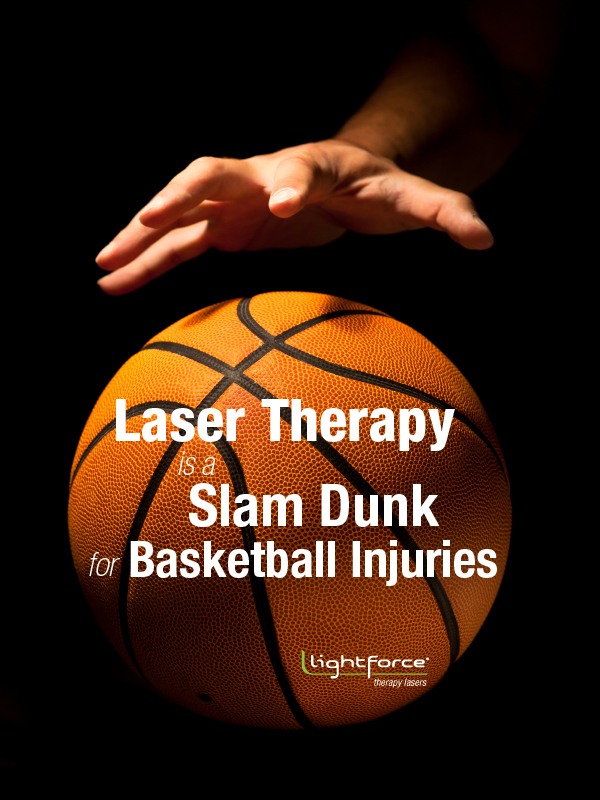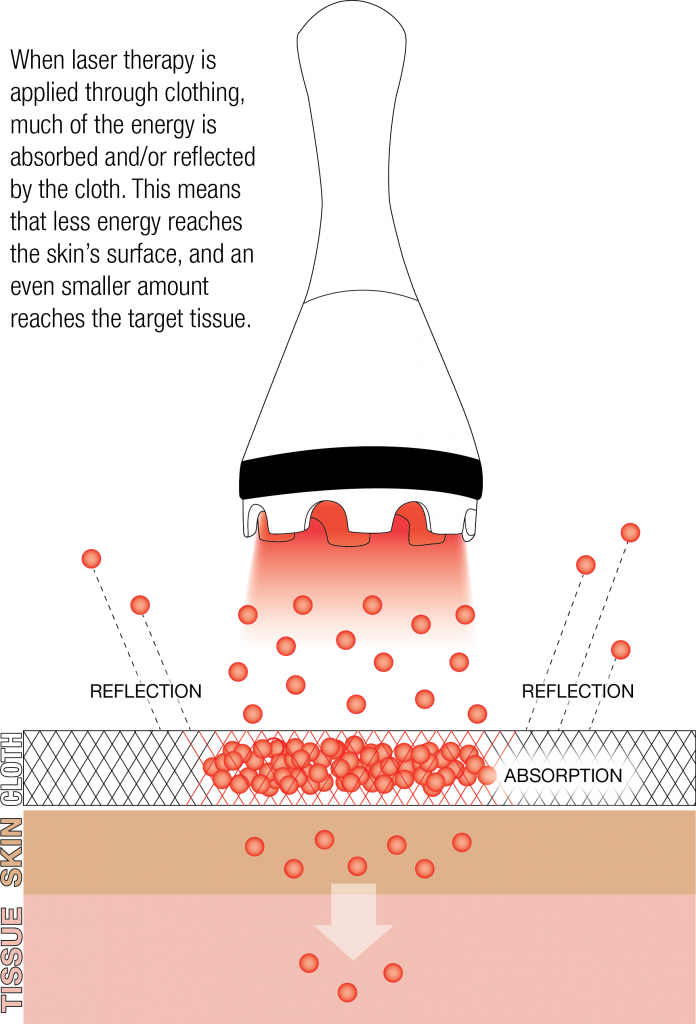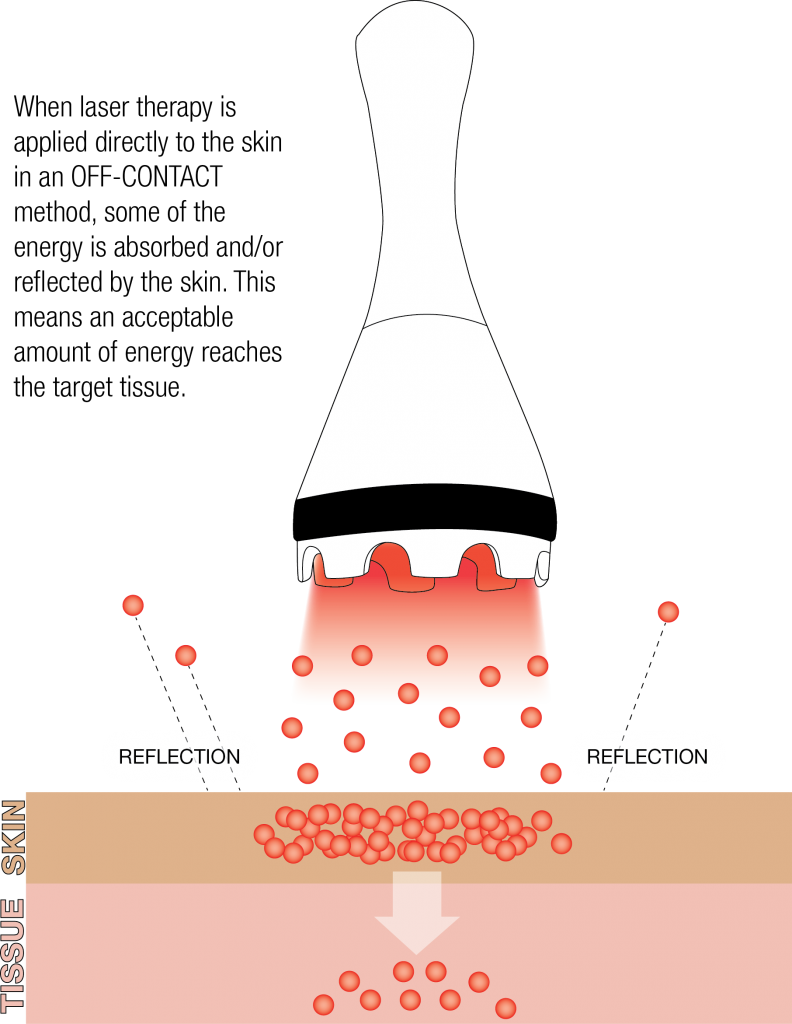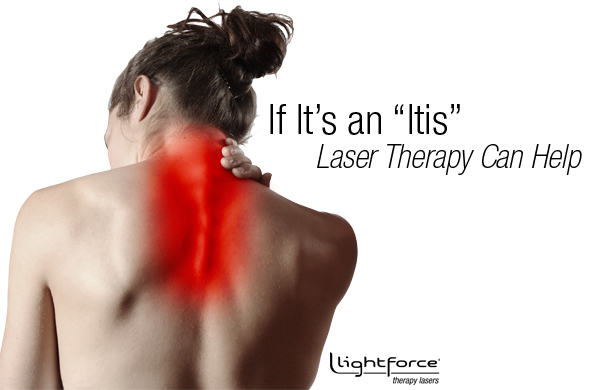Learn tips about Class IV laser therapy and other health related topics on the LightForce Therapy Lasers blog! Check back weekly for updated posts.
Guest Blog by Perry Nickelston DC, NKT, FMS, SFMA

Basketball players stack up the miles – both on the court and on their bodies. Fouls, falls, and failure to rest lead to acute and chronic injuries that can end games and occasionally careers. Prevention and treatment of these injuries is a primary concern for practitioners and players alike.
Laser therapy is helping to address this concern by quickly and effectively treating pain and inflammation related to numerous common basketball-related injuries. Here are 3 common basketball injuries and the recommended treatment protocols for each:
Ankle Sprains:
The most common basketball injury is the ankle sprain. This injury often occurs when a player lands on another player’s foot or the ankle rolls inward (inversion) during a pivot motion, stretching and tearing ligaments (partially or completely). Treatment for ankle sprains often involves immobilization via casting or taping, ultrasound or muscle stimulation.
Laser therapy is also a very effective modality to help reduce swelling and pain, and to accelerate recovery time. Laser light triggers ATP production to accelerate the repair of damaged cells and growth of healthy new cells, including those that make up cartilage (chondrocytes), bone (osteocytes), and connective tissue (fibroblasts). The sooner you can apply laser therapy to an ankle sprain, the quicker the recovery will be.
Treatment suggestions:
Acute stage: Lower power (5-6 W) and lower dosages (6-7 J/cm2), with an average total dose of 1,500 J. Treat daily for 3 days and then every other day. Total number of sessions depends on the client.
Chronic stage: Higher power (10-15 W) and higher dosages (8-10 J/cm2), with an average total dose 3,000 J. Treat every other day for 4-6 sessions.
Knee Injuries
Knee injuries are some of the most serious basketball related injuries. Knee sprains, meniscus tears and ACL tears occur often. To help the injuries heal, immobilization is often a first go-to option for treatment. After rest, progression to stretching and strengthening exercises is typical if surgery is not indicated.
In addition to rest and strengthening exercises, decreasing inflammation helps further the recovery process. Laser light fights excess inflammation by increasing the anti-inflammatory cytokines that bring chronic inflammation to an end. They lower the number of neutrophil cells that can contribute to chronic inflammation, and they increase the number of macrophage cells in the immune system, helping to remove damaged cells.
Treatment suggestions:
Treat areas surrounding and including the location of pain in an off-contact method.
Acute stage: Lower power (5-6 W) and lower dosages (6-7 J/cm2), with an average total dose of 1,500 J. Treat daily for 3 days and then every other day. Total number of sessions depends on the client.
Chronic stage: Higher power (10-15 W) and higher dosages (8-10 J/cm2) with an average dose 3,000 J. Treat every other day for 4-6 sessions.
Overuse Injuries
Relentless practice and a demanding competitive game schedule can lead to overuse injuries. The constant start, stop, pivot, acceleration and deceleration motions can put strain on joints and soft tissue.
One common overuse injury is patellar tendinitis, or “jumper’s knee,” which is characterized by pain in the tendon just below the kneecap. Achilles tendinitis is another common overuse injury, causing pain in the back of the leg and foot that can often take a player out of competition for extended periods of time. Players who engage in repetitive shooting motions also frequently suffer from tendinitis in the rotator cuff and elbow that can drastically impact their ability to shoot effectively.
Laser therapy is a great option for treating injuries such as this because it preferentially affects damaged cells, or cells that are struggling to function and need cellular energy the most. Cells that have a limited blood supply and lack of oxygen due to poor circulation are more sensitive to near-infrared laser light than are well-functioning cells.
Treatment suggestions:
Acute stage: Lower power (6-7 W) and lower dosages (6-7 J/cm2), with an average total dose of 1,800 J. Treat daily for 3-5 days and then every other day. Total number of sessions depends on the client progress. Use the open cone attachment for bony areas and the massage ball for deeper tissue.
Chronic stage: Higher power (10-15 or more W) and higher dosages (10-12 J/cm2), with an average dose 3,000 J- 5,000 J. Treat every other day for 4-6 sessions.
To see how collegiate programs are using laser therapy to keep their athletes in the game, read this article recently published in Advance Magazine outlining the role laser plays in Duke’s athletic programs.
Have you ever looked around on a beach and seen people wearing long-sleeved shirts? While this might not be the expected wardrobe option, especially on a hot day, it’s one that makes sense for people who want to limit their sun exposure. Even a lightweight fabric is remarkably efficient at keeping the sun’s energy from reaching your skin.
Sometimes, however, you may not want that extra layer of protection from light energy. When receiving laser therapy treatments, for instance, the best outcomes are achieved when the proper amount of energy is able to reach its target within the body. If there is a layer of clothing, a dressing, a bandage or a cast between the laser and the skin, much, if not all, of the energy is lost to the material before it can enter the body.
How lasers interact with clothing
 Laser light can interact with surfaces in one of three ways: reflection, absorption, or transmission. Laser therapy works best when reflection off the skin’s surface is minimized, and absorption into the tissue maximized. By adding a layer of fabric, the laser light is not able to interact with the body in the same way. Depending on the color of the fabric, either a greater amount of reflection off the fabric, or absorption into the fabric, will take place. This means that less of the energy is reaching the skin’s surface, and even less is reaching its target within the body.
Laser light can interact with surfaces in one of three ways: reflection, absorption, or transmission. Laser therapy works best when reflection off the skin’s surface is minimized, and absorption into the tissue maximized. By adding a layer of fabric, the laser light is not able to interact with the body in the same way. Depending on the color of the fabric, either a greater amount of reflection off the fabric, or absorption into the fabric, will take place. This means that less of the energy is reaching the skin’s surface, and even less is reaching its target within the body.
One way to visualize this concept is to picture a tightly woven chain link fence and someone holding a bucket full of ping-pong balls. The fence represents a layer of fabric, while the balls represent the photons (or energy). If you were to throw the ping-pong balls at the fence, some would bounce off, while some would get stuck in the fence itself, leaving far fewer to make it to the other side. Laser light behaves in much the same way when it comes in contact with fabric.
Why power loss matters
Why is this concept so important? Well, this loss of energy can have dramatic effects on treatment outcomes. Laser therapy treatment protocols rely on a certain amount of energy being distributed over a given area, so when less than the recommended amount of energy is delivered, results will be variable and often disappointing.
This layer loss effect is even more pronounced with lower-power lasers. Class III lasers, for example, emit a maximum of 0.5 W, while some Class IV lasers, like the LightForce EXP, can emit at powers up to 25 W. Let us say, for demonstration purposes, that a layer of fabric  causes a 75% power loss. This means that a Class III laser emitting at 0.5 W is only delivering 125 mW to the skin’s surface when treating through clothing, while a Class IV laser emitting a 25 W is still delivering 6.25 W to the skin’s surface. Based on the therapeutic relevance of these different doses, there will be a much larger disparity between the expected and actual results for the Class III laser than the Class IV. However, neither scenario is advisable. To ensure adequate dosing, laser therapy needs to be applied directly to the skin, in either a contact, or non-contact manner.
causes a 75% power loss. This means that a Class III laser emitting at 0.5 W is only delivering 125 mW to the skin’s surface when treating through clothing, while a Class IV laser emitting a 25 W is still delivering 6.25 W to the skin’s surface. Based on the therapeutic relevance of these different doses, there will be a much larger disparity between the expected and actual results for the Class III laser than the Class IV. However, neither scenario is advisable. To ensure adequate dosing, laser therapy needs to be applied directly to the skin, in either a contact, or non-contact manner.
Losing layers, improving outcomes
While clothing may be beneficial on a beach, it acts as an undesirable barrier during a laser therapy treatment session, preventing much of the laser energy from reaching its target. By stripping off the common misconception that it is acceptable to treat through clothing, dressings or any material, you will greatly improve outcomes by delivering more consistent and effective treatments.
To learn more about how fabric affects the delivery of laser therapy, watch the video below.
Guest Blog by Dr. Perry Nickelston DC, NKT, FMS, SFMA
If you are a medical professional or a word buff, you probably know that when the suffix “itis” is added to the end of a word, it indicates the presence of inflammation. There are so many common conditions that include this suffix in their nomenclature that people often don’t think about the inflammatory component. Yet looking at the naming conventions of medical conditions can help us better understand their qualities, and more importantly, potential treatments.
When developing a treatment plan for “itis” conditions, you can expect that inflammation reduction will play a key part in the treatment process. Typically, patients focus on relieving the pain, while the clinician may be focused on both relieving the pain and reducing the inflammation to not only make the patient more comfortable in the short term, but also encourage resolution of the condition and permanently reduce discomfort.
Common therapeutic approaches for pain and inflammation reduction include ultrasound, electrical muscle stimulation and ice. Each of these methods does their part in reducing pain and inflammation, but there is another method that also works wonders – laser therapy.
What makes laser therapy an excellent choice for patients and clinicians looking to reduce both pain and inflammation? For one, it is non-invasive, fast, and effective. Additionally, laser light works with the body on a cellular level, specifically targeting damaged cells and tissues, to activate the body’s own analgesic and inflammatory mechanisms. The effects are also photochemical in nature, not photothermal, so thermal damage to tissue is not a concern as it may be with other common treatments. Finally, laser therapy can also increase vasodilation, helping to bring vital nutrients to damaged areas.

Here are 3 common and stubborn “itis” conditions that laser therapy works wonders on:
1. Arthritis
Treatment plans for chronic “itis” conditions, like arthritis, usually focus on maintenance of pain and inflammation, rather than complete resolution. Often, several medications are used to alleviate the symptoms – typically one or more for each symptom, and occasionally additional ones to manage the side effects.
Laser therapy presents a great option for people looking for a drug-free, non-invasive treatment option. Class IV therapy lasers are particularly effective for treating the pain and inflammation related to arthritis because they are more powerful and can deliver larger doses in shorter treatment times. When treating chronic conditions like arthritis, larger dosages are recommended for maximum relief. Dosage applications range from 6-10 joules/cm2 depending on the area being treated, for a total of 600-1,000 joules of laser energy per 100 cm2. Treatments every two days for 6-10 sessions is recommended.
2. Epicondylitis
Epicondylitis is another common condition that is notoriously difficult to treat and resolve. Cortisone shots are a common treatment for this condition, and can be effective for temporary relief of pain and inflammation at the injection site. However, these treatments are not without side effects, and do not generally facilitate long-term relief or resolution.
Physical therapy is also commonly used to treat this condition and frequently results in positive outcomes. Depending on the situation, therapists may decide to use manual manipulation only or they may opt to incorporate modalities. When incorporating modalities, one great tool to help physical therapists increase the frequency of these positive outcomes is laser therapy.
Laser therapy has been shown to effectively treat this condition, without side-effects, by promoting long-term relief from the symptoms associated with chronic epicondylitis. It can additionally be used to treat areas other than the direct site of pain, which is especially helpful in chronic cases that frequently see the development of satellite pain sites. A dosage of 6-8 J/cm2 is recommended, for a total of 600-800 J of laser energy per 100 cm2. Average treatment for an elbow is 3,000 J. Moving the elbow joint through flexion, extension, supination, and pronation during treatment is effective at delivering laser energy to tissue and keeps the client actively involved. Most cases require 8-10 treatment sessions.
3. Plantar Fasciitis
Most people have either suffered from plantar fasciitis themselves or have known someone who has. It can be an extremely painful condition that patients struggle to find relief from. Treatment options range from orthotics such as inserts, splints, and boots, to medications such as aspirin or even opioids. Patients can also engage in certain exercises to help stretch and strengthen the area.
Physical therapy is another treatment option that is especially effective when coupled with laser therapy. The laser helps to reduce the pain and inflammation quickly to enhance the positive effects from the physical therapy. The laser can also be used to relieve inflammation in areas such as the calf and hip, which may either be contributing to or affected by the initial condition.
Application of the massage ball on the calf and soles is very helpful in delivering laser energy and manual therapy to troublesome trigger points that refer pain to the foot. The recommended dosage for this condition is 8-10 J/cm2, for a total of 800-1,000 joules per 100 cm2. Plantar surface of the foot usually gets between 1,500-2,000 J and the calf and Achilles receive 3,000 J. Typically, 6-10 treatment sessions are advised for this condition.
Watch a plantar fasciitis treatment video here.



